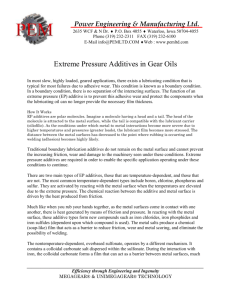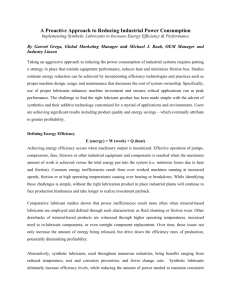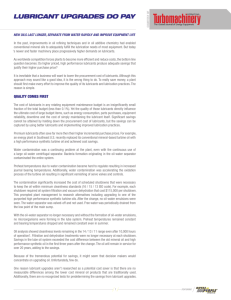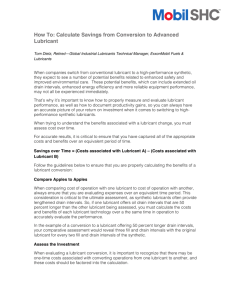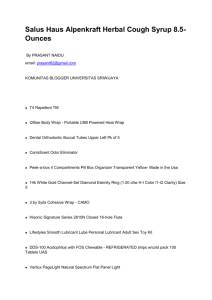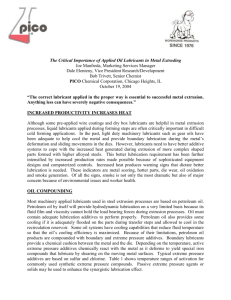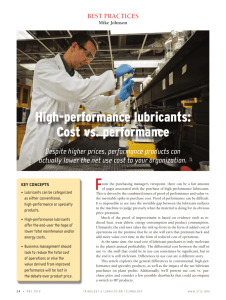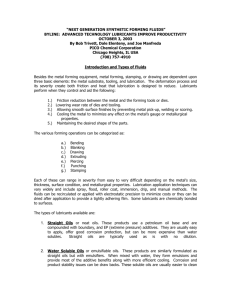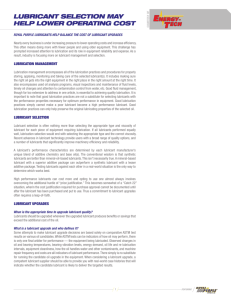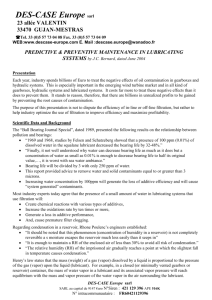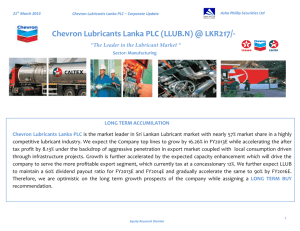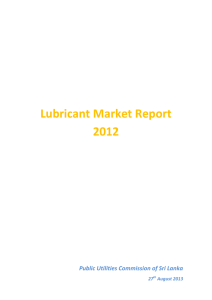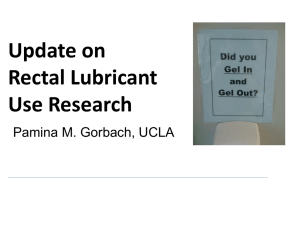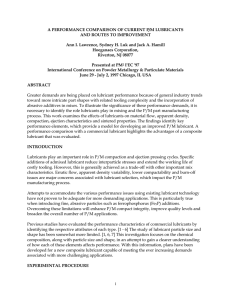Achieving Peak Performance in Extreme Service
advertisement
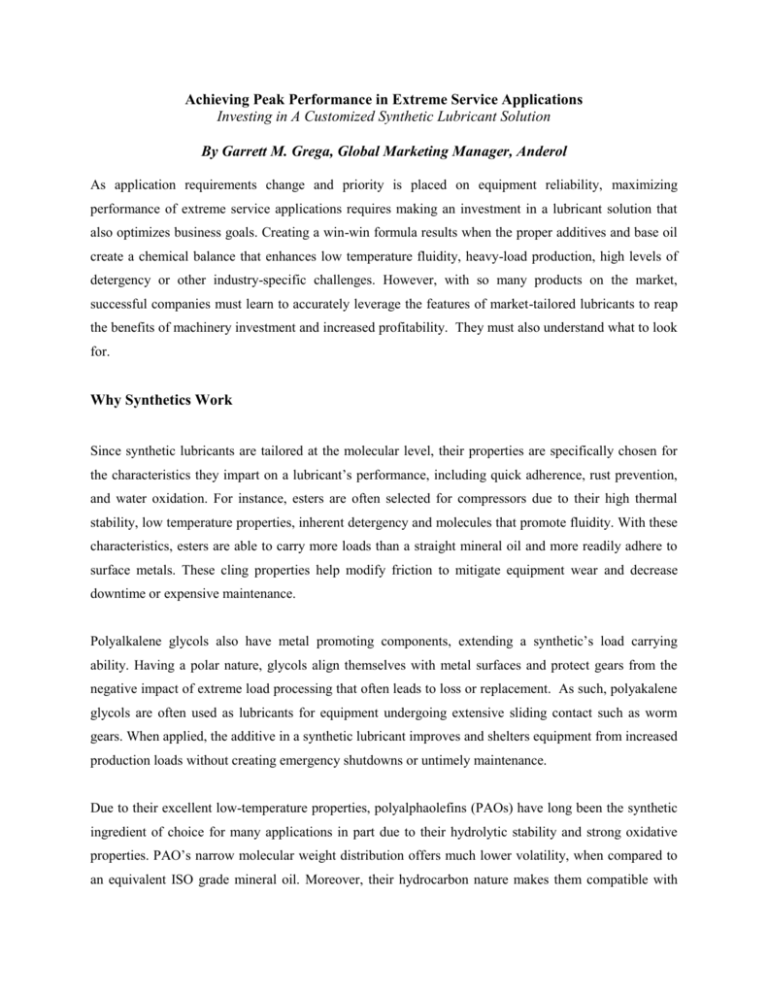
Achieving Peak Performance in Extreme Service Applications Investing in A Customized Synthetic Lubricant Solution By Garrett M. Grega, Global Marketing Manager, Anderol As application requirements change and priority is placed on equipment reliability, maximizing performance of extreme service applications requires making an investment in a lubricant solution that also optimizes business goals. Creating a win-win formula results when the proper additives and base oil create a chemical balance that enhances low temperature fluidity, heavy-load production, high levels of detergency or other industry-specific challenges. However, with so many products on the market, successful companies must learn to accurately leverage the features of market-tailored lubricants to reap the benefits of machinery investment and increased profitability. They must also understand what to look for. Why Synthetics Work Since synthetic lubricants are tailored at the molecular level, their properties are specifically chosen for the characteristics they impart on a lubricant’s performance, including quick adherence, rust prevention, and water oxidation. For instance, esters are often selected for compressors due to their high thermal stability, low temperature properties, inherent detergency and molecules that promote fluidity. With these characteristics, esters are able to carry more loads than a straight mineral oil and more readily adhere to surface metals. These cling properties help modify friction to mitigate equipment wear and decrease downtime or expensive maintenance. Polyalkalene glycols also have metal promoting components, extending a synthetic’s load carrying ability. Having a polar nature, glycols align themselves with metal surfaces and protect gears from the negative impact of extreme load processing that often leads to loss or replacement. As such, polyakalene glycols are often used as lubricants for equipment undergoing extensive sliding contact such as worm gears. When applied, the additive in a synthetic lubricant improves and shelters equipment from increased production loads without creating emergency shutdowns or untimely maintenance. Due to their excellent low-temperature properties, polyalphaolefins (PAOs) have long been the synthetic ingredient of choice for many applications in part due to their hydrolytic stability and strong oxidative properties. PAO’s narrow molecular weight distribution offers much lower volatility, when compared to an equivalent ISO grade mineral oil. Moreover, their hydrocarbon nature makes them compatible with other mineral oils, creating a non-interruptive transition when replacing with a synthetic. And like other synthetics, the absence of wax promotes a fluidity at low temperatures that ensures critical machinery components are consistently getting the lubrication needed for stable processing. As a result of these varied benefits, PAO’s are important in applications conducted at well-below freezing temperatures to prevent clogging and lubrication. The Right Additives Synthetics have achieved success throughout many critical applications based on additive technologies formulated to solve industry-related challenges and extend equipment performance. Key to performance success is having a proper chemistry balance. When synthetic lubricants are formulated to increase a lubricant’s life, gear performance or productivity, antioxidants and load-carrying additives, such as sulfurphosphorous chemistries, are the most common ingredients. The first provides for increased operating temperature ranges and the second helps prevent the negative instances of metal-to-metal contact. What makes antioxidants unique is their sacrificial nature. Once they bind with a radical molecule or a degraded molecule, they are consumed and cannot be replaced. What’s more, as these molecules become more complex, they increase the molecular intensity to extend equipment life, without hindering performance. Antioxidants properties are also known to slow the degradation rate of the oil, resulting in the need for fewer lubricant change outs, promoting business costs savings. Antioxidants Table Antioxidant Operating Regime (deg F) Drain Intervals BHT N-Phenyl-L-Benzenamine N- Phenyl- 1Naphthylamine Increasing Operating Temperature Increasing Drain Intervals “Future Chemistry” The above table shows that as the antioxidant chemistry becomes more complex, the lubricant operating regime increases. One may tradeoff increased operating temperatures with longer drain life. Formulating Balance Achieving optimum load carrying capacity requires an adequate mixture of sulfur and phosphorous chemistry to mitigate metal-to-metal contact. The main priority is to ensure the right adsorption is taking place at the metal surface since both elements have different affinities to metal. Specifically, sulfur adsorbs to the surface creating a molecular film layer that can later react to form sulfides. Phosphorous, having a different metal affinity, tends to “bind” itself to the surface. In addition, the choice of base stocks may have a profound effect on the load carrying additive performance. This becomes yet another consideration when formulating an extreme service lubricant. Having the proper ratio of each element prevents molecular competition where opposing effects result in surface “gaps” leaving the metal surface subject to attack. Instances of proper protection are realized when the right additive element is allowed to work at the right time. For example, if the goal is to inhibit the impact of frictional wear, the presence of a rust inhibitor must not interfere with a wear inhibitor’s ability to create a bond with the metal surface that enhances machinery operability. Other negative impacts are witnessed when phosphorous molecules are “sheared” through various contacts with the opposing surface, creating molecular sized occlusions that make the surface vulnerable to chemical attacks. Deciphering an accurate formula between antioxidants, extreme pressure, anti-wear, rust inhibitors, metal deactivators, and antifoam agents and base oils is best left up to expert lubricant formulators. Cold-weather Solutions Finding an effective, extreme-weather solution that meets the cold temperature API specifications for the oil and gas industry has long been a significant challenge. Specially formulated synthetics are leading the pack due to unique base-stock compositions able to solve premature equipment wear, downtime and inadequate pump jack flow. These solutions are ideal for regions accustomed to nine-month winters -such as in Northern Canada. And with this availability, processors are estimated to realize not only lowtemperature pumpability, 14% (on average) reduced energy consumption, decreased start-up torque and 5% lowered amperage -- ultimately driving down business costs. These numbers come from comparative testing to see how synthetics weigh against mineral based products. Overall, it has been determined that a synthetic’s superiority derives from a selective chemistry coupling wear with heavy load additives to readily meet potential threats defined by oil pumping in frigid temperatures, while bringing cost savings. For example, because synthetics have proven to be cleaner, costly repair and maintenance is minimized. Other savings are expected from the need of 5-year change outs as opposed to three -- maximizing equipment investment. And, synthetics outperform minerals in terms of a lower viscosity index, pour point and a more obvious separation from water, lessening appearances of rust and corrosion, protecting against outright replacement. Avoiding Micropitting Advanced synthetic technology has also been used to create PAO-based products to serve industrial processing equipment prone to micropitting or a failure of high shock-loaded systems. Designed with high-temperature capacity, these specialty lubricants are currently being assessed on machinery, including wind turbines. Results of a 250+ four-ball wear demonstrate superior anti-wear performance at elevated loads and temperatures. What’s more, available synthetics prevent appearances of micropitting, commonly characterized by small (less than 10 microns) visual gray specs on the gear teeth often causing catastrophic gear impediments and downtime. The most obvious differentiator of synthetics are their excellent strength able to negate negative impacts of excessive load processing as well as a cleanliness that keeps machines running at peak. Other benefits include machine longevity and consistent performance. Once again, these positive results come from specialized extreme application formulas, able of anticipating and solving processing challenges their competitive counterparts have not been engineered to handle. Conclusion As the need for industrial business efficiency continues to grow, the more important maintenance becomes of critical machinery applications. Making this process simple requires a strategic approach to lubrication that weighs in the benefits of industry specific products created to meet specific challenges ranging from heavy loads to low temperature fluidity. And, as lubricant technology continues to advance companies must take the time to investigate all available products to ensure processing and manufacturing is consistent and profitable investment over the long term. For more information, please contact, ANDEROL at +1 (973)-887-741, e-mail info@anderol.com or go to www.anderol.com. ###


